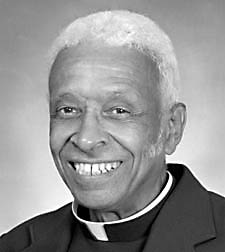
Father Jerome LeDoux, SVD,
REFLECTIONS ON LIFE
By Father Jerome LeDoux, SVD
When I was told that Charles Clifford Chenier had died and that his funeral was assigned to me, I was calm until I heard that he was a Tuskegee Airman.
“Oh no!” I told myself. “How did I live so near Charles Clifford Chenier for two years without discovering that he was a Tuskegee Airman?” No one mentioned it in my hearing and, looking back, I saw no dots that I could connect to find out. I now regret that I did not ask proactively, “Is there a Tuskegee Airman living nearby?”
It was quite different at Our Mother of Mercy Church in Fort Worth, Texas, where Claude Platte was a faithful member and where there was periodical chatter about him and the Tuskegee Airmen. At Tuskegee in Alabama, he went through the paces of the “Tuskegee Experience” where he received the Flight Instructor rating. This rating cleared him to train cadets and to fly dignitaries around the country to exciting places such as Bethune College where legendary educator Mary McLeod Bethune was officiating a graduation at her school. As a primary flight instructor, Captain Platte trained more than 400 blacks to solo and fly PT13s, PT17s and PT19s.
A native of Opelousas, Louisiana, Charles Chenier came into the world courtesy of Theodore and Albertha Chenier on October 27, 1924. He left us for the wide blue yonder of heaven on September 23. Between those bookends, he did primary and high school at Holy Ghost Church in Opelousas until his interest turned toward a hot, new experiment for Negro pilots in Tuskegee, Alabama. So, several years after Claude Platte, he cast his lot with the pilots in Tuskegee.
Shame to tell, World War II was still a time when many people thought that black men lacked intelligence, skill, courage and patriotism. When political pressure challenged the government to expand the role of blacks in the military, the Army Air Corps was the first agency to accept the challenge.
Tuskegee Institute, a small black Alabama college, was chosen to host the “military experiment” to train black pilots and support staff.
With a strong desire to serve the United States of America to the best of their ability, young blacks came from all over, especially New York City, Washington, Los Angeles, Philadelphia, Chicago and Detroit. This was an amazing response from “second-rate citizens.”
Those who possessed the physical and mental qualifications were accepted as aviation cadets to be trained initially as single-engine pilots and later as either twin-engine pilots, navigators or bombardiers. Most were college graduates or undergraduates. Others demonstrated their qualifications through comprehensive entrance examinations. They became known as the Tuskegee 332nd Fighter Group, or, popularly, as the Red Tails, identified by the brilliant color of the fighter tails.
It is important to note that no standards were lowered for the pilots or any of the others who trained in operations, meteorology, intelligence, engineering, medicine or any of the other officer fields. Being black did not equate to getting a break or pass on standards.
Enlisted members were trained to be aircraft and engine mechanics, armament specialists, radio repairmen, parachute riggers, control tower operators, policemen, administrative clerks and all of the other skilled jobs necessary to fully function as an Army Air Corps flying squadron or ground support unit. They, too, had prime training.
During World War II, segregation was the order of the day, even in the U.S. Army, with no respect given to the Negroes who put their lives on the line for their country. Nevertheless, white bomber pilots did not want any but the Negro pilots of the Tuskegee 332nd Fighter Group to escort them on their missions whenever that bomber escort group was available. “Give us the Red Tails!” they always insisted.
Those white bomber pilots did not care what color the Tuskegee 332nd Fighter Group was. All they knew was that, uniquely, the bombers escorted by that group always returned home to fly another mission some other day.
Charles Clifford Chenier returned home after the Red Tails disbanded in 1946 and busied himself as a civil rights activist in the ongoing fight against racism. He was a physical education instructor and basketball coach at D.C. Wolfe High School. He worked with the State Health Department and the Tuskegee Job Corps and was a master welder who taught veterans. He loved his 49-year wife Margaret and their children: Deborah, Brenda, Lois, stepdaughter Sonja (of wife Sonja after Margaret’s death). Charles served Holy Ghost Church and the Knights of Peter Claver.
(Father Jerome LeDoux, SVD, has written “Reflections on Life since 1969.)
